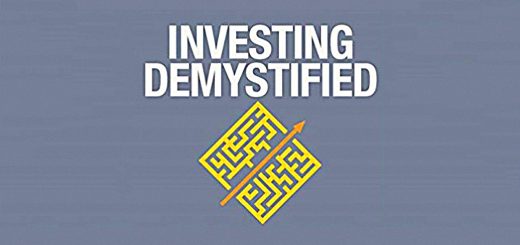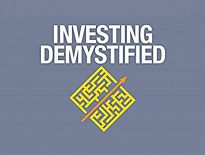Investing Demystified 1 – Markets and Portfolios

Today’s post is our first visit to a book that is popular with passive investors in the UK – Lars Kroijer’s Investing Demystified.
Contents
Lars Kroijer
I first came across Lars Kroijer on the Monevator site, but his book is increasingly popular on the UK finance subreddits (perhaps second only to Tim Hale’s Smarter Investing).
- Lars is Danish, but lives in London.
- He has an economics degree from Harvard, and an MBA from the business school there.
Until 2008, Lars was a hedge fund manager (market neutral special situations, since you ask) and he wrote a book about that (Money Mavericks).
- He now works at Alliedcrowds.com, which “aggregates alternative capital into the world’s lower-income countries”.
Lars claims to invest his own money along the lines discussed in the book. (( I find this pretty hard to believe, because I would have a hard time doing this myself, and I assume that Lars has more money than me ))
Investing Demystified
Regular readers will know that I am not a 100% passive investor.
- From what I have read prior to this book, Lars is – so I don’t expect to agree with everything he writes.
He also pushes what I would call a “Lazy Portfolio” of only two funds.
- See my series of posts on this subject for my detailed position on these.
The one-liner is that they are suboptimal, particularly for investors with larger portfolios.
- I also struggle to see how such a simple approach can fill a 250-page book.
So don’t expect a ringing endorsement from me for this book.
- But in the spirit of education, I will look for common ground where possible.
Efficient markets
Lars starts the book with the premise that markets are quite efficient, and the majority of people are not able to outperform them.
- I will take issue with this, but first, we need to define terms:
For now, I will assume that by “markets”, Lars means the market-cap weighted indices, like the FTSE-100 or the S&P 500.
- These are by definition averages, and 50% of market participants should beat them (before costs).
They are also inappropriate as benchmarks for private investors.
- You need your own benchmark that reflects the likely composition of your ideal and practical portfolio.
That won’t be 100% local stocks for anyone.
Further, market cap weighting is a poor way to construct an index or to weight a portfolio.
- If you want a simple alternative, equal weighting is better.
If you can tolerate the (relatively simple) maths, then risk parity or volatility parity is even better.
- This applies across assets and geographies as well as within a single stock market.
As to efficiency, truly efficient markets would not exhibit simple outperformance factors like momentum, value, small size, low volatility and quality.
- So for me, markets are not efficient, and outperformance is not difficult.
Moreover, you can outperform through portfolio construction and the use of factor funds.
- You can do even better with a trend-following overlay.
But you don’t need to invest actively.
- You don’t need to believe in market timing (though I do, in the limited sense of avoiding/mitigating severe downturns).
- You don’t need to think you can pick the star active managers of the future in advance (I know I can’t).
I can see the appeal of lazy portfolios to novice investors, and those with small pots.
- But that’s not the same as saying they are the best option, as many people now say online.
To me, it’s like saying that buying a ready meal from the supermarket is better than learning to cook.
Who is the book for?
Lars provides a few examples of people who might get something from the book:
- People who feel they aren’t getting value for money from the finance industry.
- Which would be almost everyone.
- People who want a simple portfolio, but who want the best return for the risk they are willing to take.
- I’m afraid you usually can’t have both – the best portfolio is not often the simplest.
- People who don’t want to stock pick.
- People who are busy with a day job.
- People with a long-term outlook.
The rational investor
Lars calls the rational investor someone who does not think than he can outperform the markets, or pick funds than can do that for him.
- I clearly disagree with this, so I will refer instead to the unambitious investor. (( I don’t intend this to sound mean – I decided against the lazy investor ))
Lars wants people to “embrace that we do not have an edge”.
- Which is a little too close to a 12-step program for me.
Lars also stresses the importance of costs and taxes, which is good to see.
- He’s also a fan of liquidity.
Active funds
Lars is against active funds because they are too expensive.
- I generally agree though I have an allocation to actively-managed investment trusts.
These tend to be cheaper than active OEICs, and have a good long-term track record, particularly in esoteric and illiquid markets.
- I also like to have satellite portfolios with less than perfect correlations to my core passive portfolio.
- They help to reduce volatility and hence boost my Sharpe Ratio.
Lars says that the only equity investment you need is a global equity tracker.
- The other fund in Lars’ portfolio is a government bond fund.
- He allows for additional government and corporate bonds, but they are not essential.
There’s no doubt that this portfolio is cheap and simple to include in tax wrappers.
- But it will be market-cap weighted, and thus not the optimum portfolio.
Saying that active funds can be beaten is not much of a claim – they are a bit of a straw man.
- Fund managers have constraints (career risk, peer comparisons, short-term benchmarking) that don’t apply to DIY investors.
The comparison reminds me of the way that robo-advisors compare themselves to the most expensive options in the market (St James’ Place, Hargreaves Lansdown etc).
- Sure you are cheaper than them, but are you cheaper than a DIY ETF portfolio?
In the same way, Lars’ two-fund portfolio will do nicely against the average active fund.
- It has to, almost by definition, since its costs are so much lower.
But will it beat my volatility parity portfolio, with factor and trend overlays?
- I don’t think that it will, in a risk-adjusted sense.
Edge
Chapter 2 of the book is about edge, which Lars thinks that most people don’t have.
He opens the chapter with a challenge to beat the S&P 500 with a subset of the 500 stocks “or even the 500 stocks weighted differently from the index”.
- This one is easy – equally weight all 500 stocks.
The next step is to compare “little old us” with the might of a unit trust research department.
Lars also thinks that most people can’t time the markets.
- This is a complicated question, but it’s relatively easy to avoid major drawdowns using simple trend following techniques (moving averages, time momentum etc).
He also points out that active investing is more expensive, because of commissions, spreads and taxes.
- That’s true, but it doesn’t mean that it can’t be profitable.
The rational portfolio
Chapter 3 is about the key components of the rational portfolio.
We already know what they are:
- The minimum risk asset
- The world equity tracker
Foreign government bonds and corporate bonds are also allowed.
It’s worth discussing the minimum risk asset a little.
- People usually take bonds to be the minimum risk asset.
Lars prefers a local currency government bond of the appropriate maturity to match the investor’s time horizon.
- That would mean the 30-year gilt for me.
But bonds have risks too, principally counterparty risk (risk of default), interest rate risk and inflation risk.
You can avoid counterparty risk by choosing bonds from your own government (assuming you live under a stable regime and have your own currency).
- And you can avoid interest rate risk by holding bonds to maturity (though strictly you still have reinvestment risk of the same rate of return no longer being available when you reach maturity).
- You can avoid inflation risk by choosing inflation-linked bonds (linkers).
Ideally, something like US Treasury bills (of 1 year and less to maturity) would be ideal, but they don’t exist in the UK.
- It’s also worth noting that buying individual bonds to hold to maturity is not easy for UK private investors.
So you might consider easy access savings accounts or government products like premium bonds, or inflation-linked certificates (not available at present) as risk-free.
When you have a small allocation to bonds and cash (say 20% of your portfolio) this is not a serious problem.
- But if you are a conservative investor, with a 40% or even a 60% bond allocation, you will need to think carefully about where you put your money.
Risk
Lars chooses five risk levels to drive stock allocation:
- 100% stocks
- 75% stocks
- 50% stocks
- 25% stocks
- 0% stocks
He makes no attempt to map these risk levels to investor profiles.
- Only levels 2 and 3 should be of interest to most investors.
The three risk levels I normally discuss in portfolio construction are:
- 75% stocks
- 60% stocks
- 40% stocks
Most investors should target one of the first two portfolios.
- But those investors with lots of non-listed assets (myself included) might struggle to get much above a 40% stock allocation (as a share of overall net worth).
Home bias
Lars is not a fan of home bias, but I am.
- See Some Home Bias is Okay for more details.
In contrast, Lars’ portfolio suffers from what I call Away Bias.
- The equity portion is 55%+ allocated to a single geography (the US).
Conclusions
That’s it for today.
- We’re perhaps a fifth of the way through the book, though I struggle to imagine what will fill the remaining two hundred pages.
We haven’t found much common ground today:
- Costs, taxes, diversification and liquidity are all important things to consider when constructing your portfolio.
Lars thinks that markets can’t be beaten by most people.
- I think that market-cap weighting is sub-optimal.
Volatility parity portfolios with factor and trend-following overlays will outperform on a risk-adjusted basis.
Lars thinks that we need only two assets – stocks and bonds.
- I think there are many alternative assets that can add value to a portfolio.
- See the Perfect Portfolio for more details.
I’ll be back in a few weeks with the next section of the book, which looks at assets in more detail.
- Until next time.















